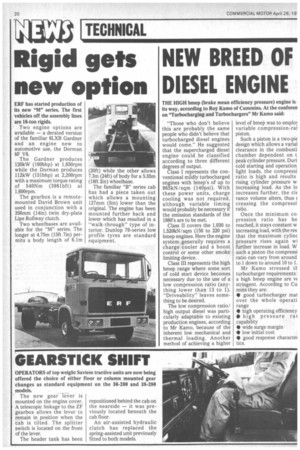NEW BREED OF DIESEL ENGINE
Page 22

If you've noticed an error in this article please click here to report it so we can fix it.
THE HIGH bmep (brake mean efficiency pressure) engine is its way, according to Roy Kamo of Cummins. At the conferen on "Turbocharging and Turbochargers" Mr Kanto said: "Those who don't believe this are probably the same people who didn't believe that turbocharged diesel engines would come." He suggested that the supercharged diesel engine could be classified according to three different degrees of output.
Class I represents the conventional mildly turbocharged engines with bmep's of up to 965kN/sqm (140psi). With these power units, charge cooling was not required, although variable timing would probably be necessary if the emission standards of the 1980's are to be met.
Class II covers the 1,030 to 1,520kN/sqm (150 to 220 psi) bmep engines. Here the engine system generally requires a charge cooler and a boost control or some other smoke limiting device. .
Class III represents the high bmep range where some sort of cold start device becomes necessary due to the use of a low compression ratio (anything lower than 13 to 1). "Driveability" leaves something to be desired.
The low compression ratio/ high output diesel was particularly adaptable to existing production engines, according to Mr Kamo, because of the inherent low mechanical and thermal loading. Another method of achieving a higher level of bineji was to emplo,1 variable compression-rat piston.
Such a piston is a two-pie design which allows a varial clearance in the combusti chamber dependent on t peak cylinder pressure. Duni cold starting and operation light loads, the compressi ratio is high and results rising cylinder pressure w increasing load. As the lo increases further, the cle rance volume alters, thus creasing the compressi ratio.
Once the minimum co pression ratio has be reached, it stays constant w increasing load, with the res that the maximum cylinc pressure rises again wi further increase in load. W such a piston the compressi ratio can vary from around to 1 down to around 10 to I.
Mr Kamo stressed tt turbocharger requirements a high bmep engine are NI( stringent. According to Cu mins they are: • good turbocharger mat over the whole operati range • high operating efficiency • high pressure rat capability • wide surge margin • low initial cost • good response charactei tics.




























































































































